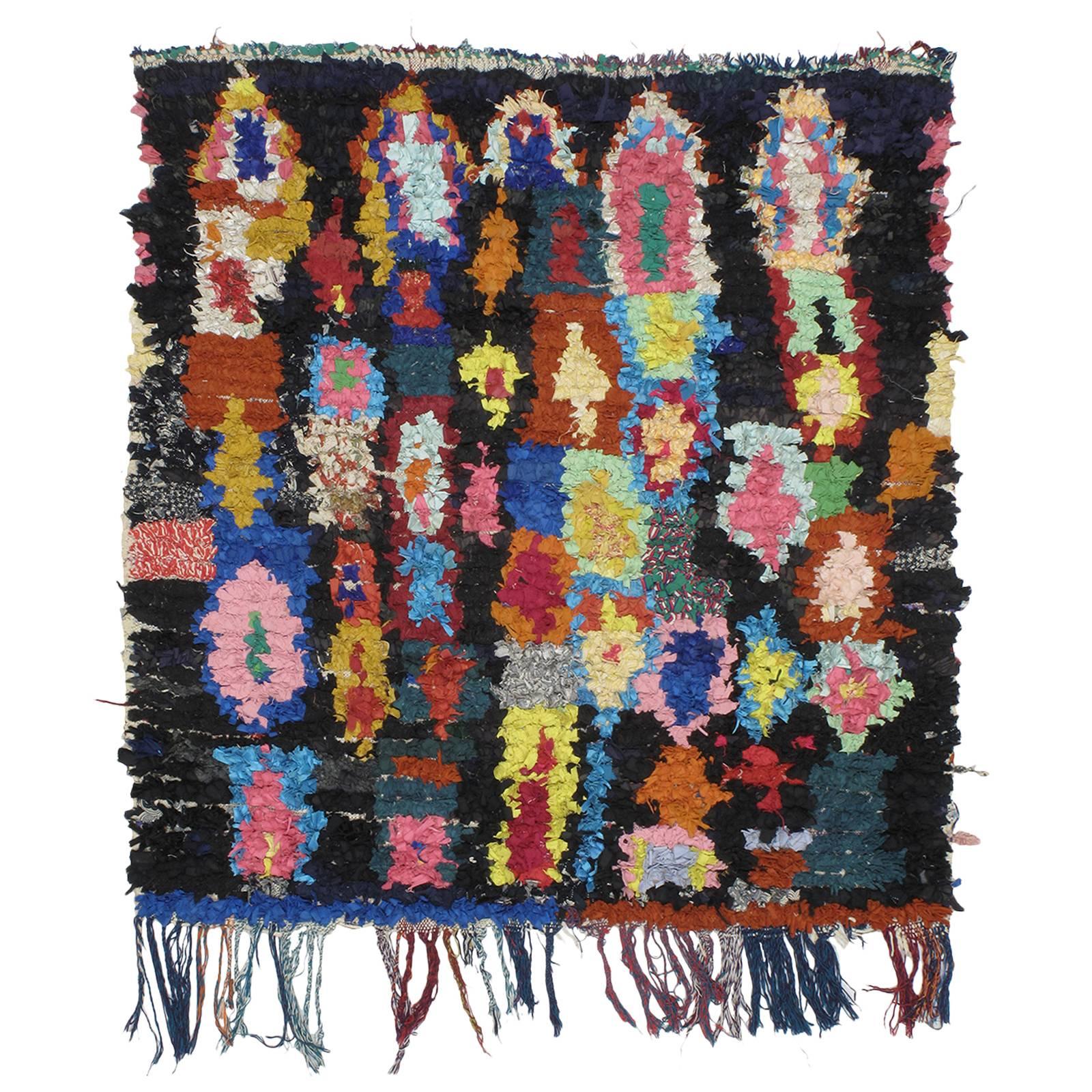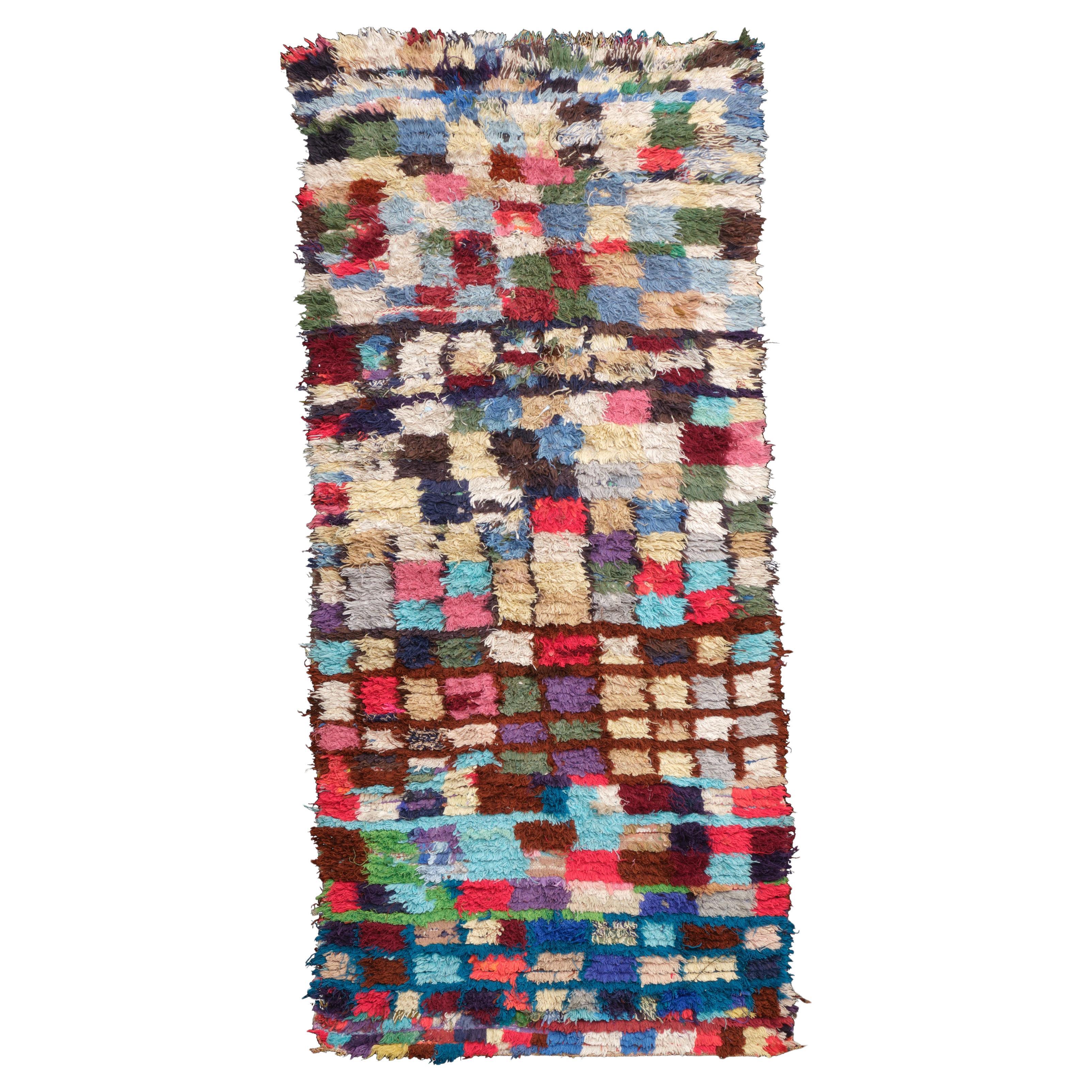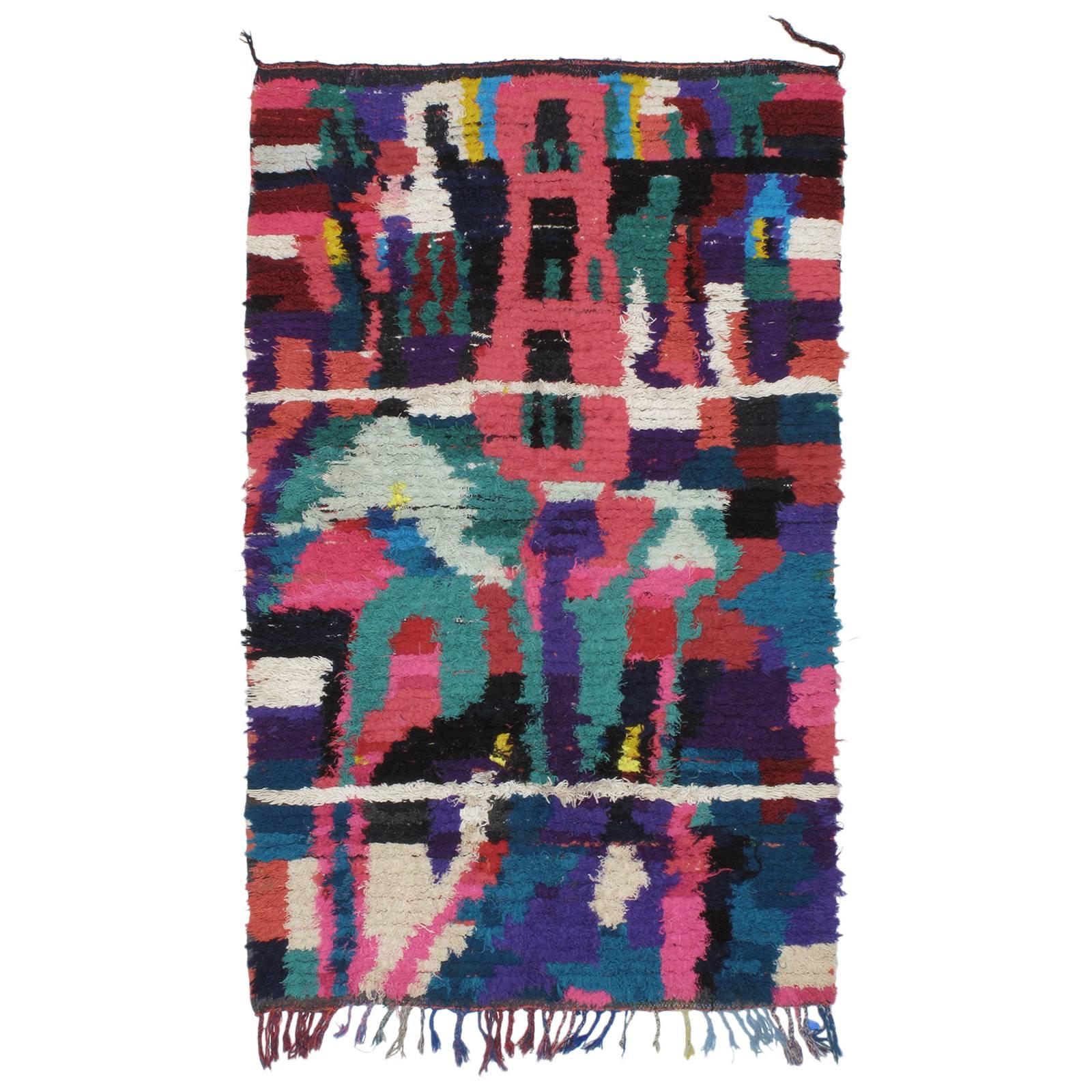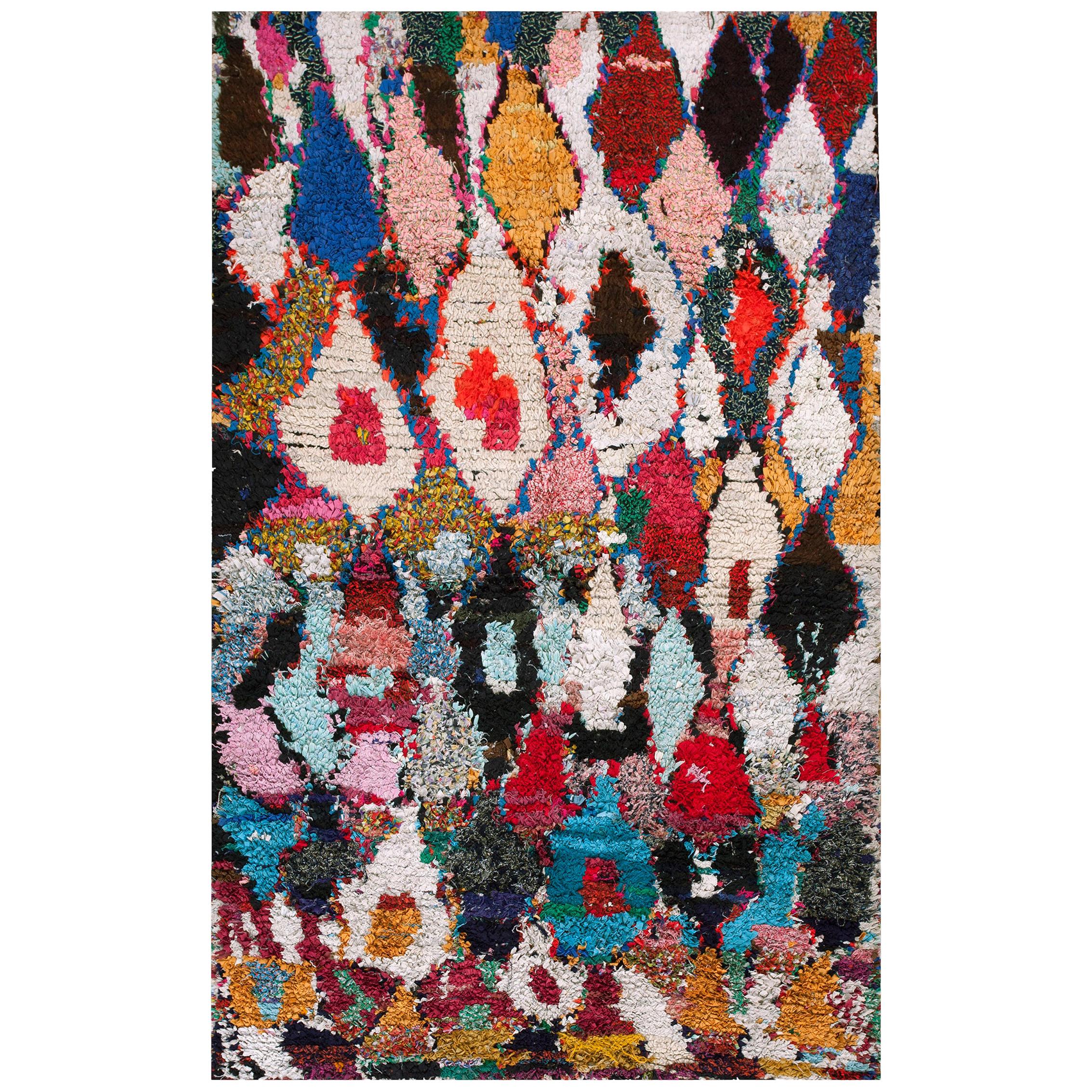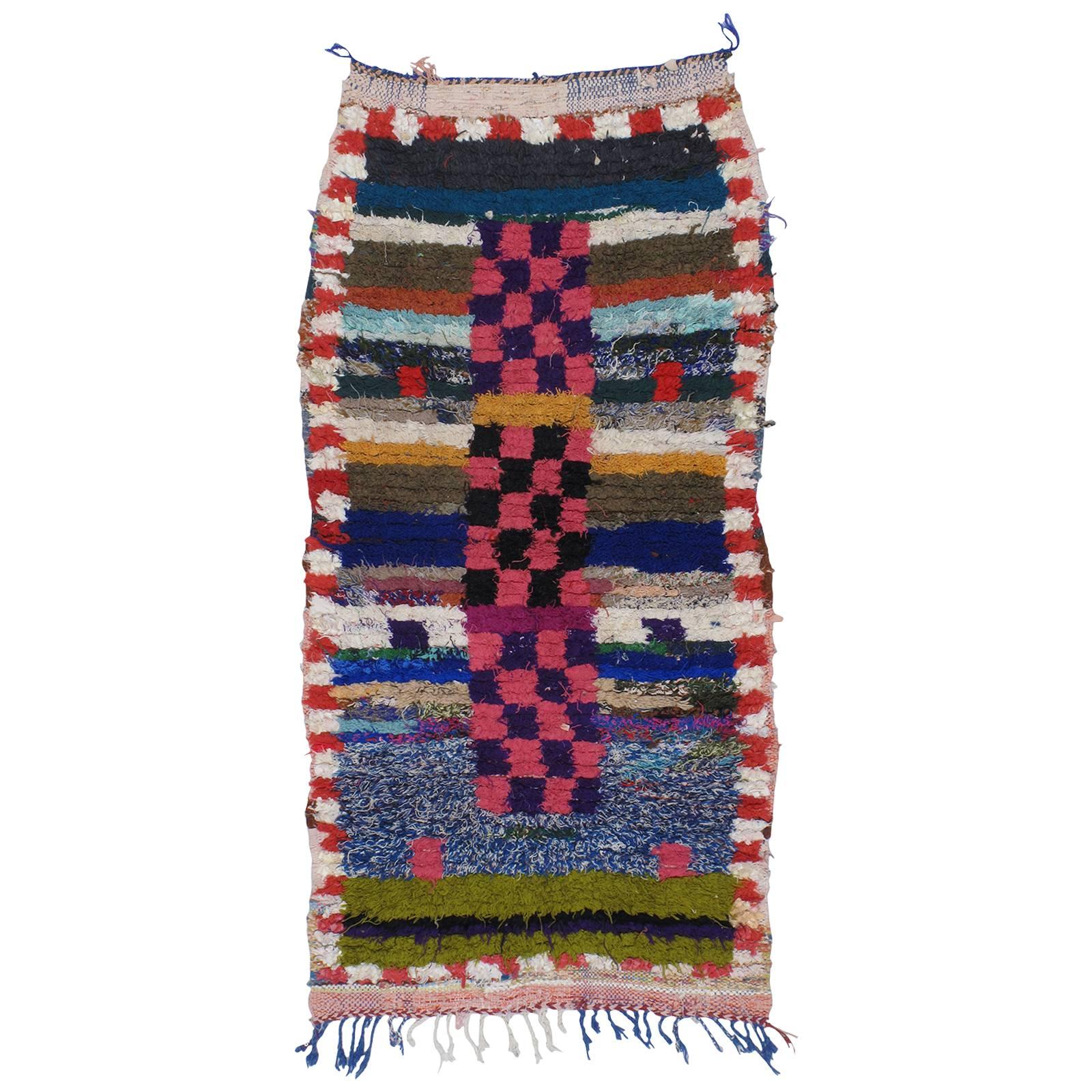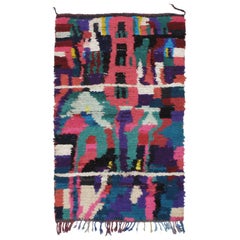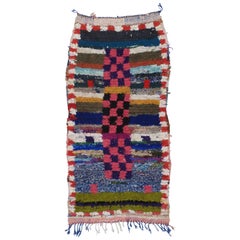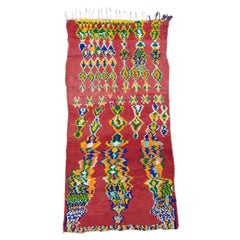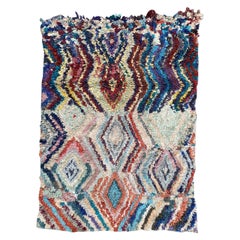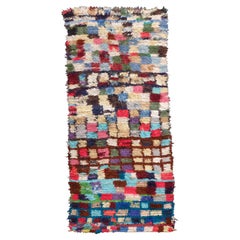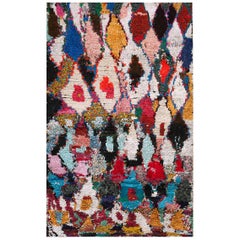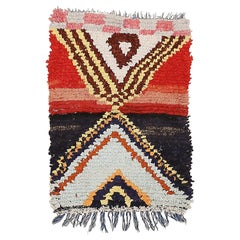Want more images or videos?
Request additional images or videos from the seller
1 of 10
Moroccan "Boucherouite" Rug
$1,160
$1,45020% Off
£860.76
£1,075.9620% Off
€1,002.67
€1,253.3420% Off
CA$1,614.73
CA$2,018.4120% Off
A$1,798.15
A$2,247.6820% Off
CHF 935.84
CHF 1,169.7920% Off
MX$22,170.92
MX$27,713.6520% Off
NOK 11,918.58
NOK 14,898.2320% Off
SEK 11,202.31
SEK 14,002.8920% Off
DKK 7,481.19
DKK 9,351.4820% Off
Shipping
Retrieving quote...The 1stDibs Promise:
Authenticity Guarantee,
Money-Back Guarantee,
24-Hour Cancellation
About the Item
Moroccan "Boucherouite" rug. A Moroccan rag rug, woven entirely with cut-up pieces of fabric from old clothes, etc. - boucherouite means rag or torn cloth in Moroccan Arabic. A relatively recent phenomenon, such weavings are products of socio-economic changes in Moroccan society, with nomadic tribes settling in towns, abandoning animal husbandry and losing access to wool. A very creative, artistic response by talented Moroccan women to changing life circumstances.
- Dimensions:Width: 35 in (88.9 cm)Length: 74 in (187.96 cm)
- Style:Tribal (In the Style Of)
- Materials and Techniques:Cotton,Hand-Knotted
- Place of Origin:
- Period:
- Date of Manufacture:Late 20th Century
- Condition:Very well preserved, sturdy and clean.
- Seller Location:New York, NY
- Reference Number:Seller: DK-101-391stDibs: LU85624178073
About the Seller
5.0
Recognized Seller
These prestigious sellers are industry leaders and represent the highest echelon for item quality and design.
Established in 2002
1stDibs seller since 2008
180 sales on 1stDibs
- ShippingRetrieving quote...Shipping from: New York, NY
- Return Policy
Authenticity Guarantee
In the unlikely event there’s an issue with an item’s authenticity, contact us within 1 year for a full refund. DetailsMoney-Back Guarantee
If your item is not as described, is damaged in transit, or does not arrive, contact us within 7 days for a full refund. Details24-Hour Cancellation
You have a 24-hour grace period in which to reconsider your purchase, with no questions asked.Vetted Professional Sellers
Our world-class sellers must adhere to strict standards for service and quality, maintaining the integrity of our listings.Price-Match Guarantee
If you find that a seller listed the same item for a lower price elsewhere, we’ll match it.Trusted Global Delivery
Our best-in-class carrier network provides specialized shipping options worldwide, including custom delivery.More From This Seller
View AllMoroccan "Boucherouite" Rug
Located in New York, NY
Moroccan "Boucherouite" rug. A Moroccan rag rug, woven entirely with cut-up pieces of fabric from old clothes, etc. - boucherouite means rag or torn cloth in Moroccan Arabic. A relatively recent phenomenon, such weavings are products of socio-economic changes in Moroccan society, with nomadic tribes settling in towns, abandoning animal husbandry and losing access to wool. A very creative, artistic response by talented Moroccan women...
Category
Late 20th Century Moroccan Tribal Moroccan and North African Rugs
Materials
Cotton
Azilal Moroccan Berber Rug
Located in New York, NY
Azilal Moroccan Berber rug. A lovely Moroccan Berber rug from the Azilal province in the Central High Atlas Mountains with a rather whimsical - dare we say, artistic - design and vib...
Category
Late 20th Century Moroccan Tribal Moroccan and North African Rugs
Materials
Cotton, Wool
$3,160 Sale Price
20% Off
Small Moroccan "Boucherouite" or Azilal Rug
Located in New York, NY
Small Moroccan "Boucherouite" or Azilal rug. A Moroccan rag rug, woven with cut-up pieces of fabric from old clothes, etc. - boucherouite means rag or t...
Category
Late 20th Century Moroccan Tribal Moroccan and North African Rugs
Materials
Cotton
$1,560 Sale Price
20% Off
Bright Boujad Moroccan Rug 'DK-119-9'
Located in New York, NY
Did the weaver keep changing her mind or did she know what she wanted all along? A bright and cheerful rug from the vicinity of Boujad in the Beni Mellal-Khenifra region in central M...
Category
Late 20th Century Moroccan Tribal Moroccan and North African Rugs
Materials
Wool, Cotton
Beni Mguild Berber Rug (DK-125-85)
Located in New York, NY
Beni Mguild Moroccan Berber Rug. A lovely old Moroccan Berber rug from the Middle Atlas Mountains, attributed to the Beni Mguild, featuring one of the well-known designs and the char...
Category
Mid-20th Century Moroccan Tribal Moroccan and North African Rugs
Materials
Wool
Moroccan "Boucherouite" Runner Rug
Located in New York, NY
Moroccan "Boucherouite" runner rug. A Moroccan rag rug, woven in rare runner format, entirely with cut-up pieces of fabric from old clothes, etc. - boucherouite means rag or torn clo...
Category
Late 20th Century Moroccan Tribal Moroccan and North African Rugs
Materials
Cotton
$1,160 Sale Price
20% Off
You May Also Like
Bobyrug’s Vintage Moroccan Boucherouite Rug
Located in Saint Ouen, FR
Beautiful tribal Moroccan Boucheroute rug with nice geometrical design and beautiful colors, entirely hand knotted with cotton velvet on cotton foundation.
✨✨✨
"Experience the epito...
Category
Late 20th Century Moroccan Tribal Moroccan and North African Rugs
Materials
Cotton
Moroccan, Vintage Boucherouite rug
Located in London, GB
Recycled jersey fabrics
L250 x W110 cm
Category
20th Century Western European Rugs
Materials
Fabric
Antique Moroccan, Boucherouitte Rug
Located in New York, NY
Antique Moroccan - Boucherouitte rug, size: 5'4" x 8'0".
Category
Vintage 1940s Moroccan Moroccan and North African Rugs
Materials
Wool
Dramatic Moroccan Berber Boucherouite Rug
Located in Milan, IT
Woven with the exclusive use of recycled yarns of various type, ranging from cotton to lurex, this represents 'art brut' within the domain of the textile arts. Weavings such as this ...
Category
Late 20th Century Moroccan Folk Art Moroccan and North African Rugs
Materials
Cotton
Vintage Moroccan Beni-Ourain Boujad Berber Tribal Rug
Located in New York, NY
Vintage midcentury Moroccan Beni Ourain Boujad Berber Tribal rug
Our vintage Moroccan rugs are part of a skillfully curated collection of rare and unusual designs. They are made of ...
Category
Vintage 1960s Moroccan Tribal Moroccan and North African Rugs
Materials
Wool
Vintage Moroccan Boujad Tribe Berber Rug
By Mehraban Rugs
Located in WEST HOLLYWOOD, CA
Stripes, zigzags, and central diamond motifs in a spirited array of colors including brilliant blue, burgundy, apricot, pale golden yellow, and white. The pile is composed of ribbon-...
Category
Early 20th Century Moroccan Moroccan and North African Rugs
Materials
Wool
More Ways To Browse
Arabic Clothes
Royal Vienna Cup And Saucer
Royal Worcester Ewer
Royal Worcester Regency Blue
Ruba Rombic
Ruppel Brandt
Russian Caviar
Russian Salt Cellar
Russian Silver Salt Cellar
Russian Silver Tankard
Russian Silver Tea Caddy
Russian Tea Glass Holder
Rustic Chess Table
Saap Denmark
Saarinen Tulip Table 35
Sacred Heart Of Jesus Icon
Saint Clare Painting
Saint Louis Crystal Thistle
